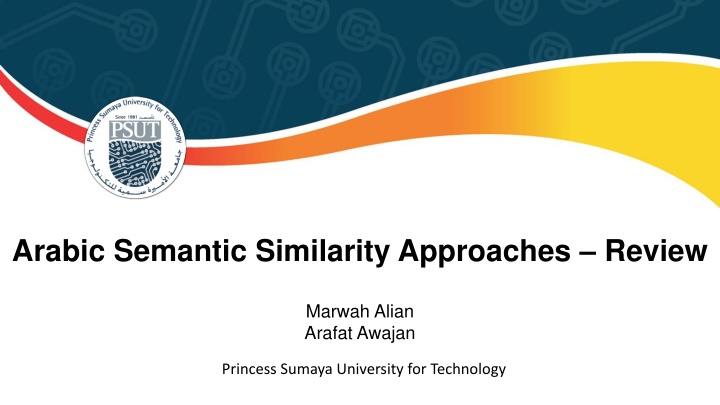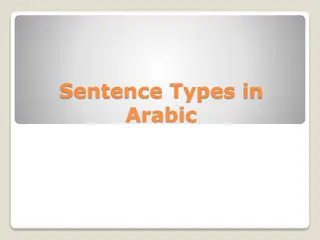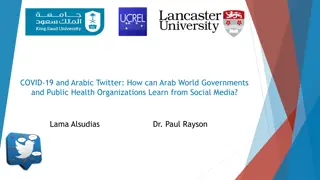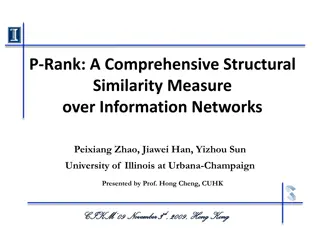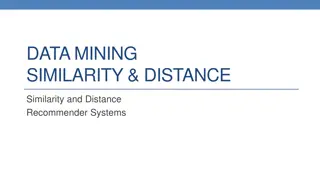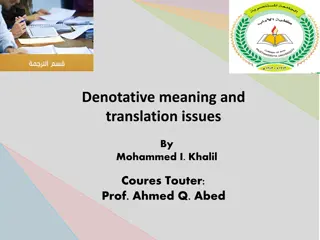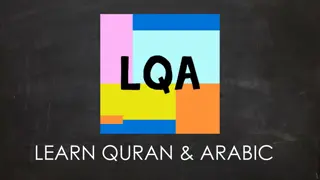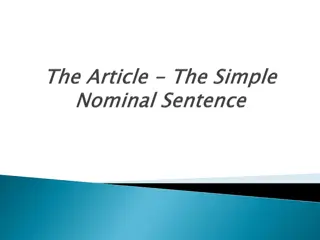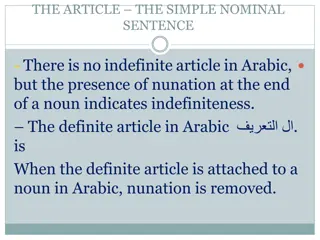Review of Arabic Semantic Similarity Approaches
This review explores various approaches to measuring semantic similarity in Arabic text. It categorizes existing research into document similarity, sentence similarity, and word similarity, comparing and summarizing the proposed methods.
Download Presentation

Please find below an Image/Link to download the presentation.
The content on the website is provided AS IS for your information and personal use only. It may not be sold, licensed, or shared on other websites without obtaining consent from the author.If you encounter any issues during the download, it is possible that the publisher has removed the file from their server.
You are allowed to download the files provided on this website for personal or commercial use, subject to the condition that they are used lawfully. All files are the property of their respective owners.
The content on the website is provided AS IS for your information and personal use only. It may not be sold, licensed, or shared on other websites without obtaining consent from the author.
E N D
Presentation Transcript
Arabic Semantic Similarity Approaches Review Marwah Alian Arafat Awajan Princess Sumaya University for Technology
Agenda Agenda Research Methodology Similarity Definition Categories of Researches in Arabic Text Review and comparison of semantic similarity researches References
Agenda Agenda Research Methodology Similarity Definition Categories of Researches in Arabic Text Review and comparison of semantic similarity researches Summary References
Research Methodology Review the effort done by researchers for the task of measuring semantic similarity for Arabic text. categorize existing researches into document similarity, sentence similarity and word similarity Then we compare between these proposed approaches. 4
What is Semantic Similarity? The similarity between two objects is related to their commonality and distance where the more commonality they share the more similar they are and the more difference they have the less similar they are. Semantic similarity is defined as a confidence score which reflects the semantic relation between two short texts (sentences) where the higher the score the more similar meaning the two texts have
Categories of Semantic Similarity work Document similarity Sentence similarity Document similarity Sentence similarity Word similarity Word similarity
Document Similarity Selamat and Ismail (2008) Technique: Self-organizing Map (SOM) and Growing Hierarchical Self-organizing Map (GHSOM) in clustering. Results: average of Precision and Recall measures for SOM was 87% and for GHSOM was 93%. H. Froud et al.(2010) Technique: Document clustering with 5 similarity measures: Jaccard Coefficient, Cosine similarity, Pearson Correlation Coefficient, Averaged Kullback-Leibler Divergence and Euclidean Distance. By), Results: Fast clustering with stemming and Jaccard that generate more coherent clusters. Al-Ramahi and Mustafa (2012) Technique: Dice s similarity measure with bi-gram word-based and whole document-based Results: N-gram document matching techniques give an accuracy level goes beyond 80%.
Document Similarity Soori et al. (2013) Technique: Using Lempel Ziv compression for detecting plagiarism. Results: 71.42% of plagiarized documents are detected. Also 28.85% from the partially plagiarized documents are found with all 100.00% of non-plagiarized documents. Awajan A. (2016) Technique: Vector Space Model (VSM), Arabic WordNet and Name Entities s gazetteers Results: By using semantic similarity for grouping text s features, the size of text representation is reduced by 27 % compared to stem-based vector space model and reduced by 50 % compared to traditional bag-of-words model. Hussein A. (2016) Technique: Using N-gram and Latent Semantic Analysis in Plagiarism detection Results: The results outperformed Plagiarism Checker X with ngram=2 and 3 since Natural Language Processing was applied in the proposed approach. 8
Sentence Similarity Alzahrani (2016) Technique: Dictionary-based translation with maximum similarity, and Machine translation with feature based similarity method Results: Machine Translation based term vector obtained correlation of 0.8657 while averaged maximum-translation produce a correlation of 0.7206 Malallah et al. (2017) Technique: Hybrid similarity measure (Semantic similarity measure, Cosine similarity measure and N-gram) Results: The hybrid technique produces better results with high performance than any of its component methods when used alone. Nagoudi et al. (2017) Technique: word embedding with weighting aligned words. Results: The no weighting method obtained a correlation rate of 72.33% while IDF- weighting and POS tagging provide a correlation of 78.2% and 79.69% respectively. 9
Word Similarity Froud et al.(2012) Technique: Latent Semantic Analysis with stemming or light stemming Results: show that Light Stemming approach outperformed Stemming approach. Almarsoomi et al. (2013) Technique: Li semantic similarity measure using Arabic knowledge base approach Results: The AWSS measure obtained a good rate of Pearson correlation which was 0.894 compared to human average of 0.893 for the same data. 10
Summary Main Approaches for measuring semantic similarity detection word co-occurrence methods which ignore word order in the sentence, and does not take the meaning into consideration. Used with documents similarity. Statistical corpus based that use the latent semantic analysis (LSA). It is successful approach in information extraction especially for documents Descriptive features-based approaches in which a word in a short text is represented using semantic features used with sentence similarity. Using neural networks and word embeddings used for short texts and documents similarity
References Ali Selamat, Hanadi Hassen Ismail, "Finding English and Translated Arabic Documents Similarities Using GHSOM", in Proceedings of the International Conference on Computer and Communication Engineering 2008, Kuala Lumpur, Malaysia, 2008, pp. 460-465 H. Froud, R. Benslimane, A. Lachkar , A. Lachkar,S. A. Ouatik, "Stemming and Similarity Measures for Arabic Documents Clustering", in 2010 5th International Symposium On I/V Communications and Mobile Network, Rabat, 2010, pp. 1-4. Mohammad A. Al-Ramahi, Suleiman H. Mustafa, "N-Gram-Based Techniques for Arabic Text Document Matching; Case Study: Courses Accreditation", Abhath AL-Yarmouk Basic Sci. & Eng, vol. 21, no. 1, pp. 85- 105, 2012. H. Soori, M. Prilepok, J. Platos, E. Berhan and V. Snasel, "Text similarity based on data compression in Arabic", Lecture Notes in Electrical Engineering , no. DOI: 10.1007/978-3-642-41968-3_22, October 2013. Ashraf S. Hussein, "Arabic Document Similarity Analysis using N-grams and Singular Value Decomposition", in 2015 IEEE 9th International Conference on Research Challenges in Information Science (RCIS), Athens, Greece, 2015, pp. 445-455. Awajan A., "Semantic similarity based approach for reducing Arabic texts dimensionality", Int J Speech Technol, vol. 19, no. 2, pp. 191 201, 2016. 12
References H. Froud, A. Lachkar and S. A. Ouatik., "Stemming versus Light Stemming for measuring the simitilarity between Arabic Words with Latent Semantic Analysis model", in 2012 Colloquium in Information Science and Technology, Fez, 2012, pp. 69-73. Faaza A. Almarsoomi, James D. O Shea, Zuhair Bandar, and Keeley Crockett, "AWSS: An Algorithm for Measuring Arabic Word Semantic Similarity," in IEEE International Conference on Systems, Man and Cybernetics, 2013, pp. 504-509. Salha Alzahrani, "Cross-Language Semantic Similarity of Arabic-English Short Phrases and Sentences", Journal of Computer Sciences, vol. 12 , no. 1, pp. 1-18, 2016. Aseel Qassim Abd Alameer, Suhad Malallah kadhem, "Finding the Similarity between Two Arabic Texts", Iraqi Journal of Science, vol. 58, no. 1A, pp. 152-162, 2017. D. Nagoudi, E.M.B., Schwab, "Semantic similarity of arabic sentences with word embeddings", in Proceedings of the Third Arabic Natural Language Processing Workshop:Association for Computational Linguistics, 2017, pp. 18-24. Nagoudi E.M.B., Ferrero J., Schwab D., Cherroun H., "Word Embedding-Based Approaches for Measuring Semantic Similarity of Arabic-English Sentences", In 6th International Conference on Arabic Language Processing ICALP, published in : Arabic Language Processing: From Theory to Practice , Book Series: Communications in Computer and Information Science. vol. 782, 2018. 13
Thank You Thank You 14
Sentence Similarity Nagoudi et al (2018) Technique: word embedding with Weighting Aligned Words and Alignment based on a Bag-of-Words with three weighting functions. Results: Mixed weighting with Alignment based on Bag-of-Words provides a correlation of 77.39% and Weighting Aligned Words obtained a correlation rate of 73.75% = = 15
